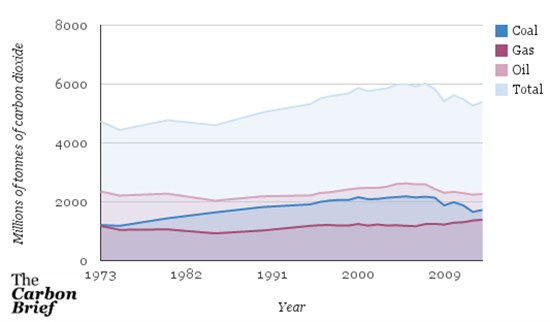Next Monday President Obama will unveil a new regulation that would aim to cut carbon emissions from coal-fired power stations by up to 20 per cent, the New York Times reports.
It will be the boldest move yet in his efforts to force America to take climate change action, despite opposition from the US Congress.
In a speech this week, Obama denounced those that “deny” climate change. He said:
“American influence is always stronger when we lead by example. We cannot exempt ourselves from the rules that apply to everyone elseâ?¦ cooperation must energize the global effort to combat climate change.”
Next Monday’s proposal stems from Obama’s Climate Action Plan, published last summer. This aims to back up a pledge to take US emissions 17 per cent below 2005 levels by 2020 and to cut them 42 per cent by 2030.
Hard-won powers
At the President’s request the US Environmental Protection Agency (EPA) finalised an emissions limit for new power stations last autumn, using hard-won powers to regulate carbon under the Clean Air Act. The EPA is working towards a 1 June 2014 deadline for a similar rule tackling emissions from existing power stations.
The standard for new plants sets a limit of 500 kilograms of carbon dioxide per megawatt hour of electricity for plants that burn coal, meaning that they would have to fit carbon capture and storage equipment capturing a portion of their emissions in order to operate.
The limit is similar to one that opposition MPs tried, but failed to introduce into the UK’s Energy Bill last year. It is about half the emissions of a typical coal plant.
The EPA won’t be able to introduce a similar rule for existing plants because it would force almost all of the country’s 600 coal-fired generators to shut down. These plants provide around two-fifths of US electricity.
Instead, media reports suggest the rule would aim to reduce coal emissions by 20 per cent at the national level rather than applying directly to individual stations.
Politically expedient flexibility
Each state would be given flexibility to meet its share of this target. It could do this by cutting coal emissions, installing solar or wind plants, cutting energy demand or by trading in carbon markets.
This could mean a growing role for state-level carbon trading schemes. The Regional Greenhouse Gas Initiative (RGGI) covering nine states in the northeastern US recently committed to annual power station emissions cuts of 2.5 per cent during 2015 to 2020, for instance.
The planned EPA rule would have much bigger impacts on some electricity firms than others and would hit coal-reliant states such as West Virginia much harder too.
A growing number of states have made recent efforts to weaken or eliminate green energy mandates or incentives. More than a dozen have done so since 2013, the New York Times says.
So giving states flexibility to meet the coal emissions reduction would make political sense, says Dr Harald Heubaum, assistant professor in global energy and climate policy at the School of Oriental and African Studies.
Massive litigation
The draft EPA rule will be subject to a one year consultation period before it is finalised. Even so, Heubaum expects a political fight starting on Monday.
Other experts agree. There will be “massive litigation” against the plans, Robert Nordhaus, a lawyer who wrote part of the 1970 Clean Air Act on which the rules would be based told the Financial Times. Earlier legal challenges reached the US Supreme Court but were ultimately unsuccessful.
A sign of things to come is a survey suggesting Americans support limits on coal, timed to pre-empt “fierce resistance from the coal industry and their allies”. Meanwhile a report from the US Chamber of Commerce says that the EPA’s rule would cost $50 billion per year until 2030.
Economist Paul Krugman points out this is relatively cheap, at 0.2 per cent of US GDP. Even so the EPA was quick to denounce the report as “nothing more than irresponsible speculation based on guesses”. So the fight seems sure to get dirty.
Rising emissions
The stakes are high. Despite Obama’s emissions-cutting zeal US emissions increased in 2013, according to figures published this week by the US Energy Information Administration (EIA). Emissions had fallen year on year in four out of the five years since 2008.
The 2.4 per cent rise in emissions during 2013 appears to have been caused by a drift from gas towards coal use. The longer-term story of falling US emissions remains intact, however. Emissions in 2013 were more than 10 per cent below the 2005 baseline used by the US to set long-term reduction targets.
Over the past five years this has been driven by a reduction in oil use (pink line), down 7 per cent, coupled with a 20 per cent drop in coal use (dark blue) and a 12 per cent rise in gas consumption (purple).

A 20 per cent reduction in coal emissions would make a relatively smaller dent in overall US emissions – perhaps 7 per cent – because the sector only emits a third of the total. But while this might seem small it could be a step on the road to greater things.
Heubaum says:
“Longer term, it could be that EPA and the federal government are able to build on this to pursue much tougher action in future.”
The world will be watching. The US initiative is described as “critical” by former UN climate chief Yvo de Boer. Delegations from the EU to China are all said to be eager to find out – just how ambitious Obama is prepared to be in the run up to next year’s climate talks in Paris?

